Loupiac, Gironde, Nouvelle-Aquitaine 作者: 来源: 发布时间:2021-09-25
I.Population and Area
Total Area: 9.57 km2
Population in 2017: 1 112
Population Density: 116 /km2
Histogram of demographic change
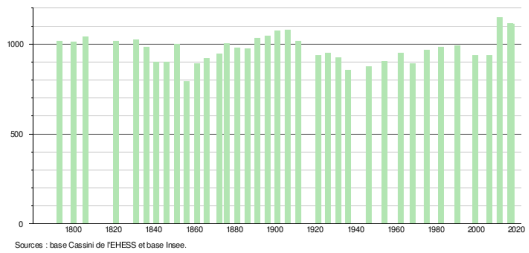
II.Natural Geography (environment and resources)
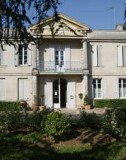
Loupiac is a town in southwestern France, located in the Gironde department, in the Nouvelle-Aquitaine region.
Geography:
Having given its name to the Loupiac AOC (sweet wine), the town of Loupiac is located in the urban area of Bordeaux and the urban unit of Cadillac on the right bank of the Garonne, 37 km south-east of Bordeaux, capital of the department, 11 km north-north-west of Langon, capital of the arrondissement and 2.5 km south-east of Cadillac, capital of the canton.
The neighboring municipalities are Donzac to the north-east, Monprimblanc to the east, Gabarnac to the south-east, Sainte-Croix-du-Mont to the south, Barsac to the west on the left bank of the Garonne, Cadillac to the north-west and Omet in the north.
Communications and transport
The main road communication route which crosses the town is the D10 departmental road which runs along the Garonne and which leads north-west to Cadillac and south-east to Saint-Maixant; North of the village, the D117 departmental road starts from this D110, crosses the village and leads south-east towards Verdelais.
The closest access to the A62 motorway (Bordeaux-Toulouse) is number 2, known as Podensac, which is 8.5 km south-west through Cadillac.
Access No. 1, known as de Bazas, to the A65 motorway (Langon-Pau) is 24 km south.
The closest SNCF station is that of Cévrier, on the Bordeaux-Sète line of the TER Nouvelle-Aquitaine, 4.5 km westward via Cadillac. That of Langon, offering more traffic, is 11 km away to the south-east.
III.Economy
Employment rate (%): 73.8 (2017)
Average employment income (€):2 057 net per month (24 684 net per year)(2018)
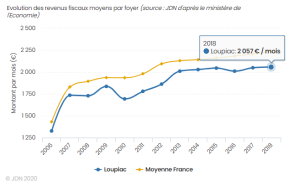
Evolution of average monthly net wages
Sources : http://www.journaldunet.com/business/salaire/loupiac/ville-33253
https://www.insee.fr/fr/statistiques/2011101?geo=COM-33253
IV.Industrial Characterisitics
Loupiac is famous for the quality of its sweet white wine.
The AOC Loupiac
Located on the right bank of the Garonne, 40 kilometers from Bordeaux, Loupiac (formerly Lupicius - the wolf) has produced wines of gold and honey for centuries.
Ideal configuration for sweet wines, the hills with rounded backs by successive erosion, have limestone subsoils at their base and clayey-gravelly on the summits. Their plump slopes with clay-limestone soils provide the vineyard with natural drainage of rainwater.
A small appellation remarkable for its dynamism, Loupiac operates small properties (maximum 10 hectares). With a common identity, these winegrowers express their passion and solidarity within the Syndicat Viticole de Loupiac.
Three grape varieties give the wines of Loupiac flavor, tone and a beautiful personality resulting from this blend: Semillon, mostly (80%), typical of this region. It brings aromatic finesse, flavor and complexity to the wines. Sauvignon (15%) gives the wines a very aromatic vigor. Muscadelle (5%) harmonizes the two previous grape varieties, giving them roundness and fragrance.
AOC LOUPIAC
Source: www.bordeaux-bestwine.com
The Loupiac vineyard, located on the right bank of the Garonne, benefits from climatic conditions favorable to noble rot and offers sweet white wines rich in aromas (honey, citrus fruits, candied fruits, etc.) and with aging potential.
- Appellation: LOUPIAC
- Region: Aquitaine (Gironde).
- Type of wines: Sweet white wines.
- Classification and appellation AOC, decree of September 11, 1936.
- Production area: 2550 hl / year for 360 ha.
- Production area: 40 km from Bordeaux, on the right bank of the Garonne, inside the town of Loupiac.
- Grape varieties: The blend is mainly based on Semillon to which is added Sauvignon and a small proportion of Muscadelle, for its color and the roundness of its flavors.
- Keeping: Very long, from 5 to 15 years.
- Serving temperature: Between 6 ° and 8 °.
- Food pairing: White meat, foie gras, parsley cheese, aperitif.
Noble rot:
Good grape degradation under certain temperature and humidity conditions.
Semillon:
Young variety with subtle and discreet aromas with hints of almonds, hazelnuts, peach or Reine Claude (plum).
Sauvignon:
Grape variety that embodies elegance and freshness. Tasty, round and lively at the same time, it has many aromas such as citrus fruits, exotic fruits, blackcurrant bud, boxwood.
Muscadelle:
A variety requiring a lot of attention in cultivation. Great floral aromatic richness.
Grape variety:
Vine plant characterized by the shape of its leaves and clusters.
Sources: http://www.commune-loupiac33.fr/L-AOC-Loupiac
V.Attractions
1.church of Saint-Pierre
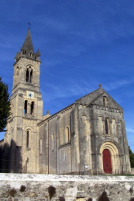
The 12th century church of Saint-Pierre, listed as a historic monument in 1840.
The western facade of the church is made up of a front section, pierced with three arches, and divided by abundantly decorated bands. Under the cornice, supported by sculpted modillions, is a frieze, dedicated to the Last Supper, between original sin and the adoration of the lamb. Saint John leans his head against the shoulder of Christ, in the midst of the 11 apostles. This scene, rather rare in France, recalls the apostolados of the Spanish churches.
Loupiac Church was an outbuilding of Sainte-Croix de Bordeaux. Tradition has it that it succeeded a pagan temple.
Numerous restorations, in particular following the fire of 1655, have profoundly changed the appearance of the church: 1720 reconstruction of the south wall, 1843 reconstruction of the eastern part, 1850-1853 recovery of the building.
The "Benedictine" plan of the apse and the bands of the facade covered with rich ornamentation demonstrate the importance of the church. The pediment shows a frieze representing: on the left the original sin, on the right the Adoration of the Lamb, in the center Christ in the middle of the 11 apostles (Saint John leaning his head on the shoulder of the Master, a theme rare enough for the underline).
The church benefited from a vast municipal renovation plan in 2003. In 2009, a Concordia site renovated and cleaned the surroundings.
The gate
The portal is not authentic, it is the result of the restoration of the architect Paul Abadie, who replaced the sculptures of the existing capitals and arches with new ones. A single capital (north opening) was spared as a witness. The drawing by Léo Drouyn, which dates from 1845, shows that the arches were in good condition and the capitals, certainly eroded, but not totally damaged.
The Saint-Pierre church was classified as historical monuments by decree of 1840.
The western facade
The facade has a front section in the center of which opens a wide semi-circular door. The Romanesque portal was replaced in the 19th century.
Above this door:
a band serves as a support for three arches supported by sculpted columns with the relief sculpture of a musician strangely placed halfway up on two twin columns.
these arches are surmounted by a large bas-relief arranged in a frieze and divided into three subjects: Adam and Eve at the foot of the tree of temptation, Christ in majesty with 11 disciples, the Mystical Lamb between two angels.
a cornice with nail heads is supported by 18 figured modillions.
a triangular pediment pierced with a semicircular opening crowns this facade.
The decor is a veritable educational monstrance and similar to the facade of the Church of Saint-Jean-d'Étampes in La Brède.
2.Cros Castle
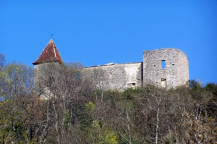
Of the castle built between the end of the 12th century and the middle of the 14th century, there is only one still covered tower (restored in 1993), a topped tower, a pavilion dating from the 17th century, and remains of walls. Rehabilitation works are in progress.
It was originally a Romanesque castle, as suggested by its construction in 1155, as attested by the Cartulaire de la Sauve-Majeure. Redesigned and reshaped over time, the overall plan before us is between the fourteenth century and the seventeenth century.
Its dominant position, on a rocky outcrop, was obviously chosen both for a defensive reason, since the castle was built for military reasons, but also for the purpose of monitoring river traffic.
During the Hundred Years War, the Château du Cros remained in the English camp, its defenders fiercely repelling the lords of Benauge. It passed from family to family over the centuries, but was continuously inhabited until World War II. This was going to be fatal to him. Indeed, the German army requisitioned it first for its ideal point of view, but also used it as a target of fire to train its soldiers. The occupation forces finished him off with explosives shortly before withdrawing. Under these conditions, at the end of the war, the castle was abandoned.
Since then, without a roof to protect it, and at the mercy of inclement weather, theft and vandalism, the site rapidly deteriorated and took on the aspect we know it today.
The building was listed in the supplementary inventory of historical monuments by decree of December 31, 1993.
3. Ricaud Castle
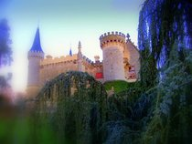
Château Ricaud Out of sight, on a hill in the upper Loupiac, nestles the magical castle of Ricaud.
This 15th century building passed into the hands of multiple families according to historical alliances.
Purchased in 1855 by J-C de Bignon, mayor of Gornac, the restoration of the castle was entrusted in 1861 to the Bordeaux architect Alphonse Blanquière (1829-1897). It is then a real reconstruction in a neo-Gothic style carried out by the architect, assisted by local cabinetmaker Laville and decorator Félix Berne Bellecour. The result is a fairy tale: strange gargoyles, slender turrets, battlements offer a most suggestive atmosphere, in this park with three hundred year old trees.
It was between 1882 and 1910 that W. Wells established a vineyard of nearly 20 hectares.
Missions
Bought in 1980 by A. Thiénot, Château Ricaud is part of a vast restructuring plan.
The castle is not open to visitors.
4.Gallo-Roman villa
Mosaics Villa Gallo-Romaine {JPEG} Located at a place called Saint-Romain, this major site includes a series of buildings which have followed one another over time:
- A peristyle villa with private thermal baths established between the 1st and the 6th and 7th centuries AD. AD and reused during the High Middle Ages.
Within the Gallo-Roman villa are thermal baths with caldarium (hot bath), tepiradium (warm bath) and frigidarium (cold bath). Mosaics very rich in colors and patterns cover the entire surface of the floors. Their considerable dimensions make it possible to imagine the importance of this ancient agricultural domain in Antiquity.
- A Benedictine priory dedicated to Saint Romain in the 11th and 12th centuries.
The house, uninhabited since 1973, is used as a place of exhibitions and scientific studies for archaeologists.
An early historiography, from the beginning of the 19th century with the first researches of R. Dézeimeris (1835-1913), suggested that Saint-Romain corresponded to the paternal villula of the poet Ausone; then the excavations of A. Pezat have uncovered an invaluable ancient and medieval heritage.
The excavation campaigns carried out between 2004 and 2008 by the archaeologist J. Marian have uncovered new historical strata such as a medieval funerary space and have enabled precise phasing.
Since 2011, the villa has been listed in the inventory of Historic Monuments.
Missions
The site is the property of Jean-Pierre Bernède, winegrower in Loupiac, who, with passion and dedication, ensures respect for the place, its development and organizes visits.
In partnership with the Association of Friends of Villa Saint-Romain and local authorities, the owner is working on making the villa more open to the public and on a project to enhance the site's museography.
The Gallo-Roman villa dating from the 2nd-5th centuries on several levels, with thermal baths where we find the caldarium, the tepidarium and the frigidarium. It is a complex network of pipes and a large 140 m3 swimming pool. Its mosaics covering all floor surfaces are extremely rich in color. From the first half of the 19th century, important Gallo-Roman mosaics were noted on the site of the Saint-Romain priory. The Loupiacais archaeologist R. Dézeimeris undertakes research. His discoveries are the subject of numerous communications to the Académie de Bordeaux in which he attempts to identify the Gallo-Roman villa of Loupiac with that of Ausone. Today, only the site of the swimming pool surrounded by mosaics and the thermal baths have been unearthed. Their considerable dimensions (12.5 mx 8 m for the swimming pool, 71 m2 of mosaics) make it possible to imagine the importance of this agricultural domain in antiquity.
Sources : http://www.commune-loupiac33.fr/Chateau-Ricaud
http://www.commune-loupiac33.fr/Villa-gallo-romaine
VI.History
During the Revolution, the parish of Saint-Pierre de Loupiac formed the commune of Loupiac. On May 15, 1816, the town of Loupiac became Loupiac-de-Cadillac, then Loupiac.
VII.Other information
Life is creative
sewing, crochet, knitting, embroidery, patchwork
Creative leisure association, whose primary goal is to bring together people around the same passion to create together, exchange ideas, share their know-how and learn.
Room of the old town hall, every Tuesday from 7:30 p.m. to 9:30 p.m.
Contact: Madame Kateryna QUASIMODO
Address: church route
33410 LOUPIAC
Email: lavieestcreative@gmail.com.
Social Cultural Or Sports Association (ACSOS)
Cultural, Social and Sports Action
ACSOS Loupiac
(Association of cultural, social and sporting actions)
ACSOS offers the following activities for the 2013/2014 season:
- Knitting and sewing workshop: every Thursday afternoon in the old town hall from 2 p.m. to 5 p.m.
- Library (membership card): every Wednesday afternoon from 5 p.m. to 6.30 p.m. at Loupiac school.
- Garage sales.
Contact: Ms. SERF Marie-France, president
Address: Roche
33410 Loupiac
Phone: 06.80.92.73.23
Email: acsosloupiac@neuf.fr
A Corps & Arts
Plastic arts or Qi Gong
PLASTIC ARTS COURSE
- Drawing workshops
- Plastic arts
- Earth modeling
Meet at the meeting room (next to the tennis courts), Saturday mornings for children aged 5 to 12, and Thursdays from 6.30 p.m. to 8.30 p.m. for adults and teenagers.
Come discover or deepen different plastic expression techniques with a qualified teacher.
For more information: 06.07.90.38.03 or www.acorpsetarts.wordpress.com
QI GONG COURSE
- Energy practice
- Harmonization, breathing
- Movements, relaxation
Meet at the kindergarten motor skills room, Tuesdays from 7 p.m. to 9 p.m.
For more information: 06.74.99.45.21 or www.acorpsetarts.wordpress.com
Contact: A Corps et arts
Address: Loupiac
33410 LOUPIAC
Email: a.corps.et.arts@gmail.com
Sources: http://www.commune-loupiac33.fr/La-vie-est-creative
http://www.commune-loupiac33.fr/Association-Culturelle-Sociale-Ou
http://www.commune-loupiac33.fr/A-CORPS-ARTS
VIII.Contact information
Loupiac town hall address :
Berthoumieu - 33410 Loupiac
Mayor : Jean-José BONNERON
Mail: mairie-loupiac@wanadoo.fr
Phone number: 05 56 62 99 62
Fax: 05 56 62 98 52
Website : http://www.commune-loupiac33.fr/
Sources : http://www.commune-loupiac33.fr/Presentation
http://www.commune-loupiac33.fr/Administration-Accueil
